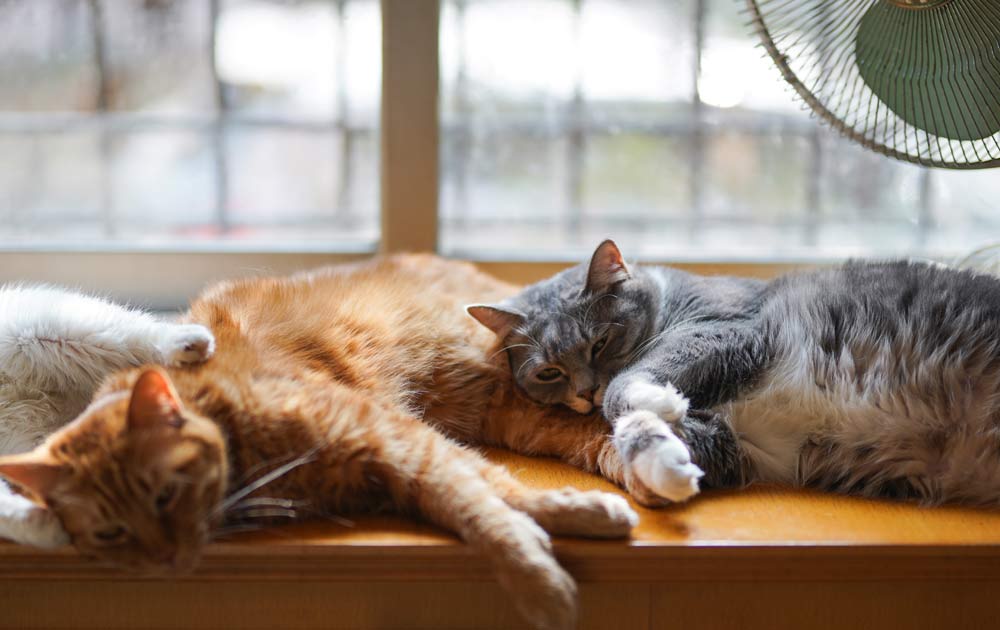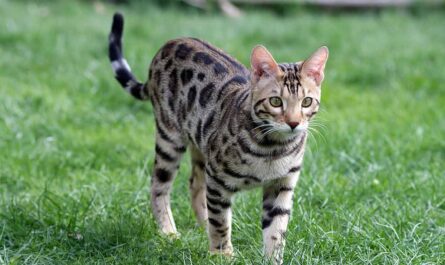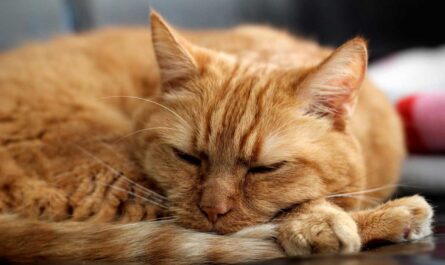Why does a cat get zoomies? Cat zoomies emerge as a captivating and enigmatic aspect of feline behavior, defying simple explanations and categorizations. These moments of unleashed energy, marked by acrobatics, vocalizations, and sudden onset, add a whimsical dimension to the feline-human relationship. As we navigate the whimsical wilderness of cat behavior, embracing the mysteries of the zoomies becomes not just an acknowledgment of feline idiosyncrasies but a celebration of the dynamic and unpredictable nature of our feline companions. This article will share insight into why a cat gets zoomies, and when to call a vet. Keep reading.
Unleashing the Whirlwind of Feline Energy
“Zoomies,” an endearing term that encapsulates the mystifying phenomena of feline energy eruptions, characterizes those moments when our otherwise composed feline companions embark on frenzied escapades. Picture this: your sedate and elegant cat transforms into a blur of motion as if possessed by an unseen force. These episodes, often marked by spontaneous bursts of vigorous activity, manifest through a medley of acrobatics – darting across the living room, executing gravity-defying leaps, scaling furniture with unmatched agility, and all-around tomfoolery.
The Theatrics of Cat Zoomies: More than Meets the Eye
Delving into the theatrics of cat zoomies reveals a captivating dimension beyond mere physical exertion. It’s not just about the gravity-defying leaps or the breakneck sprints; some feline performers punctuate their zoomies with a symphony of growls, yowls, or meows. These vocalizations add an auditory layer to the spectacle, heightening the drama and infusing an extra layer of enigma into the already perplexing phenomenon. The uninitiated observer might be left in awe, grappling with the sudden and unanticipated burst of feline theatrics.
The Enigmatic Onset and Vanishing Act
The perplexity deepens as we explore the seemingly enigmatic onset of cat zoomies. Picture a tranquil afternoon with your cat lazily basking in a sunbeam, and then, without warning, the switch flips. The once serene creature transforms into a whirlwind of activity. What triggers this sudden eruption of energy remains a puzzle – is it a hidden reserve of feline zeal, a response to unseen stimuli, or simply a capricious burst of feline whimsy? Equally confounding is the disappearing act; as swiftly as the frenzy began, it concludes, leaving behind a cat that may resume its calm demeanor as if nothing happened.
Vocal Crescendos in the Midst of Chaos
Within the cacophony of cat zoomies, a distinct layer of communication emerges through vocalizations. Growls, yowls, and meows interlace with the tumultuous physical display, transforming the spectacle into a multisensory experience. The growls, low and primal, hint at an instinctual undercurrent beneath the surface of playfulness. Yowls, perhaps a declaration of feline prowess, reverberate through the space, adding a touch of wildness to the domestic setting. Meows, the familiar language of cats, weaves through the chaos, creating a narrative that, while indecipherable to human ears, adds a mysterious depth to the performance.
From Tranquility to Turbulence: What Sparks the Feline Frenzy?
The enigma of cat zoomies extends beyond the visible theatrics and vocal symphony to the mysterious motivations that propel these episodes. Is it a surge of pent-up energy seeking an outlet, a manifestation of feline boredom seeking diversion, or a primal instinct expressing itself in the confines of domesticity? Deciphering the motives behind these sudden bursts of activity becomes an intricate puzzle, with each cat’s unique personality and history contributing to the complexity of the narrative. Understanding the motivation behind the zoomies becomes not only a quest for feline comprehension but also a journey into the nuances of the human-animal bond.
What Are Cat Zoomies?
Cats, those enigmatic creatures that weave in and out of our lives with an air of mystery, are renowned for their peculiar behaviors. Yet, amidst their penchant for lounging and aloofness, there exists a phenomenon that extends beyond the feline realm—zoomies. Astonishingly, it’s not an exclusive feline affair; dogs, too, partake in the whirlwind of activity known as zoomies.
Unveiling the Technical Tapestry: Frenetic Random Activity Periods
Within the intricate realm of veterinary language, there exists a term that encapsulates this chaotic burst of energy—frenetic random activity periods (FRAPs). The very nomenclature adds an air of sophistication to the seemingly whimsical nature of zoomies. Picture a cat or a dog dashing across the room, seemingly possessed by an invisible force. It’s a spectacle that elicits laughter and curiosity, prompting one to delve deeper into the feline psyche. Yet, what exactly unfolds during these frenetic episodes?
Peering into the Prowess: The Choreography of Zoomies
The seemingly arbitrary nature of zoomies, akin to a sudden burst of exuberance, belies a more intricate choreography. Observing a cat mid-zoomie, the question arises—what prompts this spirited display of athleticism? Contrary to popular belief, the zoomies are not an exercise in randomness. A cat, or even a dog, engages in this burst of frenzied movement for various reasons. Some motivations are deeply rooted in feline behavior, while others have ties to underlying medical factors.
Unraveling the Enigma: The Varied Reasons Behind the Feline Frenzy
Delving into the labyrinth of feline motivations, it becomes apparent that the zoomies are not a singular, one-size-fits-all phenomenon. Cats embark on these energetic escapades for a multitude of reasons. It could be an expression of sheer joy, an outlet for pent-up energy, or a playful response to environmental stimuli. Understanding the intricacies of a cat’s psyche unravels the layers of complexity within these seemingly spontaneous outbursts. Yet, there’s another dimension to consider—the medical realm.
Beyond Whimsy: The Intersection of Behavior and Health
The connection between behavior and health unveils itself as a crucial facet of the zoomies phenomenon. While joy and playfulness often take the forefront, there are instances where these bursts of activity can be indicative of underlying medical issues. Pain, discomfort, or even anxiety can manifest in the form of frenetic random activity periods. Deciphering whether a cat’s zoomies are a lighthearted display or a subtle cry for help requires a nuanced understanding of feline behavior and a keen eye for subtle cues.
Let’s explore the most common causes of the cat zoomies:
Bathroom-Related Zoomies
The enigmatic post-litter-box dash, an erratic sprint that transforms your home into a feline Grand Prix circuit, unveils a quirkier side of cat behavior. Some cats, after a successful visit to the litter box, embark on a celebratory lap, a victory dance of sorts following the euphoria of “lightening their load.” While this might be a customary feline celebration, a persistent occurrence, especially coupled with inappropriate elimination, demands the discerning eye of a veterinary professional to rule out underlying health concerns.
Sleep-Related Zoomies
Cats, those enigmatic and slumber-loving creatures, harbor a not-so-secret proclivity for extended periods of repose. Nestled within the cocoon of their catnaps, felines undergo a curious phenomenon—a resurgence of vivacity, a burst of energy that, in the untamed realm, would be a prelude to their hunting expeditions. This peculiar surge in feel-good vibes, a relic of their predatory ancestry, is none other than the infamous “zoomies.”
Hunting Instinct Zoomies
Remarkably, the domestication of cats has not extinguished the flickering flames of their primal instincts. While a saucer of kibble beckons from the comfort of the home, felines, as if under the spell of a latent call, succumb to the primordial impulse to hunt and chase. The result? The elusive zoomies materialize, transforming the domestic living room into a makeshift hunting ground, complete with imaginary prey and frenzied pounces that cascade into a whirlwind of activity.

Boredom/Lack of Activity
Picture this: a wide-eyed cat, caught in the throes of the zoomies, donning an exhilarating and slightly wild expression as it careens through the domicile with energy that seems uncontainable. The paradox of indoor safety contrasts sharply with the untamed allure of the wild. Some felines, yearning to shatter the monotony of domesticity, craft their own version of amusement—the zoomies, a kinetic rebellion against pent-up energy that threatens to bubble over.
Feline Hyperthyroidism
In the realm of feline idiosyncrasies, the zoomies, oddly enough, serve as a subtle harbinger of an underlying physiological imbalance—hyperthyroidism. Middle-aged and senior cats, victims of an overactive thyroid gland inundating their systems with an excess of thyroid hormones, find solace in the frenetic dance of the zoomies. Weight loss, insatiable hunger, heightened thirst, bouts of vomiting, and diarrhea accompany this energetic spectacle, signaling a call for a veterinarian’s expertise.
Age-Related Zoomies
As cats gracefully navigate the passage of time, seniority ushers in a different facet of the zoomies—sometimes a sign of cognitive decline and dementia. The silent orchestra of age orchestrates changes in sight, hearing, and olfactory senses, occasionally eliciting spontaneous bouts of the zoomies. If your venerable feline companion, unaccustomed to such energetic escapades, embarks on frequent zoomie escapades, it may be a symphony of signals pointing towards cognitive dysfunction syndrome (CDS).
Anxiety and Stress
In the complex tapestry of feline emotions, distress unfurls its tendrils in the form of behavioral shifts, a kaleidoscope that includes the surge in zoomie occurrences. Unsettling events, discord among housemates, or simmering tensions between feline compatriots may manifest in the chaotic dance of the zoomies. The household, marred by disharmony, becomes a canvas upon which felines paint their frenzied expressions of unease.
How To Stop Cat Zoomies?
In feline companions, the phenomenon of the “zoomies” is not just a display of eccentric behavior but often a completely normal and behaviorally appropriate expression. Some cats revel in the sheer joy of a lively romp, darting around the house with a fervor that seems almost boundless. It’s a manifestation of their instinct to burn off excess energy, turning the living space into their personal playground. Such antics, at their core, are all about the exuberant pursuit of fun.
Meeting Your Cat’s Needs
Ensuring your cat’s holistic well-being is paramount to understanding and tolerating the occasional bout of zoomies. The provision of a well-rounded environment is key – from an array of engaging cat toys and designated scratching areas to elevated perching spots and ample opportunities for play and interaction with you, the cat owner. If these needs are met, and there’s no indication of underlying health issues or psychological stress, the zoomies can be viewed as a healthy and temporary burst of energy.
Patience and Observation
Patience becomes a virtue when dealing with cat zoomies, as these spirited episodes are typically short-lived. A common expectation is that most cats won’t indulge in their energetic escapades for more than a brief five-minute window. Observing your feline friend during this time, ensuring there are no signs of distress or discomfort, is key. In the absence of concerning indicators, the general advice is to wait it out, confident that normalcy will soon be restored.
Addressing Concerns and Annoyances
Addressing concerns arising from the zoomies is a natural response, especially when considering potential harm or disruption caused by a hyperactive cat. Whether it’s the fear of injury due to leaping from heights or the disturbance caused during late-night zoomies, cat owners ponder ways to put a pause to these spirited episodes. The challenge is not just about managing the cat’s exuberance but finding a balance that keeps both the feline and the household surroundings unscathed.
Playtime as a Solution
An unconventional yet effective approach to curbing the zoomies is to actively engage with your cat during these energetic outbursts. Playing becomes a channel for redirecting their heightened energy into structured activities. Employing enticing toys like feather wands, jingle balls, or toy mice can turn the zoomies into a collaborative play session, transforming potential chaos into a controlled and enjoyable interaction. Cat accessories on Amazon
Cautionary Measures
However, a delicate balance must be maintained during playtime. Attempting to chase or cuddle with a cat experiencing zoomies may not yield the desired results. The heightened state of arousal in cats during these episodes could result in redirected aggression towards the owner, leading to unintended scratches or bites. Recognizing the need for restraint and avoiding actions that might escalate the cat’s arousal is crucial during these spirited moments.
Post-Zoomies Affection
Understanding that the aftermath of the zoomies may not immediately translate to a calm and receptive cat is crucial. Even when the frenetic activity seems to have subsided, allowing a brief period before attempting affection is recommended. Cats, in their post-zoomie state, may remain temporarily agitated, and premature attempts at cuddling might lead to resistance. Allowing a grace period of 10 to 15 minutes ensures a smoother transition from the energetic frenzy to a more tranquil and affectionate disposition, with your lap potentially becoming the preferred destination.
Other Interesting Articles
- Turkish Vankedisi Cat Profile, Traits, Health, Grooming, Care
- Ukrainian Levkoy Cat Breed: Profile, Traits, Grooming, Care
- Ussuri Cat Breed: Profile, Traits, Personality, Grooming, Care
- York Chocolate Cat Breed: Profile, Traits, Health, Care
- Tonkinese Cat Breed: Profile, Traits, Health, Grooming, Care
- Siberian Cat Breed: Profile, Traits, Health, Grooming, Care
- How to Perfectly Place A Litter Box for Your Cat? 46 FAQs
- 17 Best Types of Toys to Play at Home with Your Cat
- Snowshoe Cat Breed: Profile, Traits, Health, Grooming, Care
- Munchkin Cat Breed: Profile, Traits, Personality, FAQs, Care
- Minuet Cat Breed: Profile, Traits, Personality, Grooming, Care
- Persian Cat Breed: Profile, Traits, Personality, Health, Care
- Ragdoll Cat Breed: Profile, Traits, Personality, Grooming, Care
- Scottish Fold Cat Breed: Profile, Traits, Personality, FAQs, Care
- Russian Blue Cat Breed: Profile, Traits, Personality, FAQs, Care
- Balinese Cat Breed: Profile, Traits, Personality, Care, Facts
- Australian Mist Cat Breed: Profile, Traits, Personality, Care
- Abyssinian Cat Breed: Profile, Traits, Personality, Care, Facts
- Bengal Cat Breed: Profile, Traits, Personality, Care, Grooming
- Birman Cat Breed: Profile, Traits, Personality, Care, Grooming



